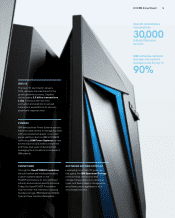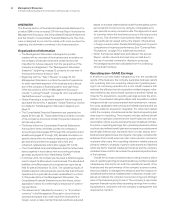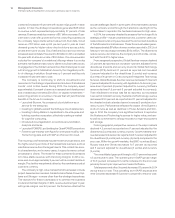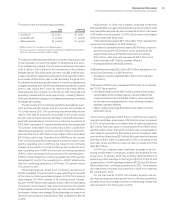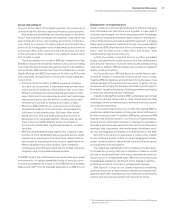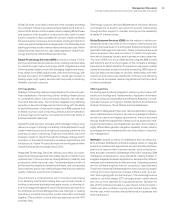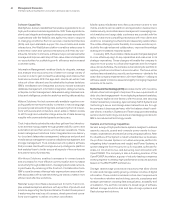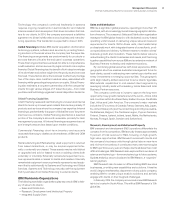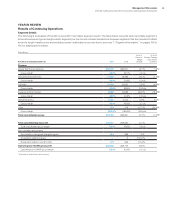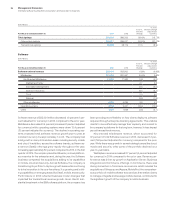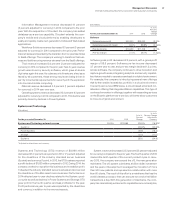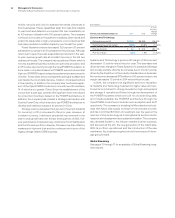IBM 2014 Annual Report Download - page 29
Download and view the complete annual report
Please find page 29 of the 2014 IBM annual report below. You can navigate through the pages in the report by either clicking on the pages listed below, or by using the keyword search tool below to find specific information within the annual report.28 Management Discussion
International Business Machines Corporation and Subsidiary Companies
2. Our Unique Strength
Data, cloud and engagement are powerful forces changing the
landscape of technology and businesses. However, enterprise
clients need more. Enterprises need to bring this new world of
technology together with the existing systems that currently run
their businesses if they are to capture their full value. This combina-
tion is what we refer to as Hybrid Cloud.
Without bringing these worlds together, these new tech-
nologies become “islands” within the enterprise. For example, a
business that invests in a social media platform engages with and
captures the sentiment of individual customers. These can be valu-
able interactions. However, much deeper insight into the needs
and wants of an individual customer comes when combining the
social media interactions with the historical purchase and engage-
ment records of that customer—as stored in existing systems. By
combining these insights, the enterprise personalizes interactions
in ways that are relevant and meaningful to that customer.
IBM is unique in bringing this Hybrid world to its clients with our
unparalleled strength in both the existing and the new worlds of IT.
IBM supports its clients’ mission critical processes, and
remains the “go-to” platform for the enterprise. For example,
more than 90 percent of the top 100 banks and the top 25 U.S.
retailers run on IBM systems. In addition, nearly half of the Fortune
100 companies outsource IT operations to IBM. The company’s
leadership in enterprise computing provides the foundation for
strategic partnerships as leading companies want to work with
IBM, as evidenced by the Apple, SAP, Twitter and Tencent partner-
ships announced in 2104.
Combine this with the company’s strength in the new worlds
of data, cloud and engagement—and IBM brings a unique and
important capability to the market.
3. Our Migration to Higher Value
Technology by itself does not create value for a business. Tech-
nology enables a business to achieve its aspirations by facilitating
richer interactions with clients and ecosystems, by unlocking
deeper insight and by enabling faster actions.
IBM has continuously evolved its mission to deliver increasingly
higher levels of business value to its clients. Starting primarily as
a hardware company, IBM has added a rich portfolio of software
and services to add higher value.
This next phase of IBM’s transformation will realize the full
breadth of the portfolio by bringing higher-value added solutions
to our clients. Examples include:
• Using predictive analytics to reduce customer attrition rates
through the IBM Customer Data solution.
• Detecting fraudulent claims before payments are made
through the IBM Counter Fraud solution.
• Preventing costly and unscheduled downtime of equipment
through early detection of anomalies with the IBM Predictive
Asset Optimization solution.
The focus on integrated solutions will make IBM a stronger partner
with its clients as the company takes another step in its continuous
evolution to higher levels of value.
Summary
One constant throughout IBM’s over 100-year history has been the
need to continually transform the company in an ever-changing
industry. Our industry, our clients—and IBM itself—is in the midst
of such a fundamental transformation.
This is a transformation of unparalleled growth and promise:
• The promise of technology to bring extraordinary levels of
insight to human endeavors through advances in analytics
and cognitive computing.
• The promise of the cloud as a catalyst for innovation, freeing
enterprises to focus more on the uses of technology rather
than just the technology itself.
• The promise of enterprises engaging with their customers,
their employees and their business partners through richer,
more personalized means.
• All underscored by security to help protect the integrity of
every interaction.
We are excited about the prospects for growth and value for our
clients—and for IBM—and we look forward to helping our clients
transform their businesses for the future.
Business Model
The company’s business model is built to support two principal
goals: helping enterprise clients to become more innovative, effi-
cient and competitive through the application of business insight
and IT solutions; and providing long-term value to shareholders.
The business model has been developed over time through strate-
gic investments in capabilities and technologies that have superior
long-term growth and profitability prospects based on the value
they deliver to clients.
The company’s global capabilities include services, software,
systems, fundamental research and related financing. The broad
mix of businesses and capabilities are combined to provide inte-
grated solutions to the company’s clients.
The business model is dynamic, adapting to the continuously
changing market and economic environment. The company con
-
tinues to divest certain businesses and strengthen its position
through strategic organic investments and acquisitions in higher-
value areas. In addition, the company has transformed itself into
a globally integrated enterprise which has improved overall pro-
ductivity and is driving investment and expanding participation in
markets with significant long-term opportunity.
This business model, supported by the company’s financial
model, has enabled the company to deliver strong earnings, cash
flows and returns to shareholders over the long term.
Business Segments and Capabilities
The company’s major operations consists of five business seg-
ments: Global Technology Services and Global Business Services,
which the company collectively calls Global Services, Software,
Systems and Technology and Global Financing.



